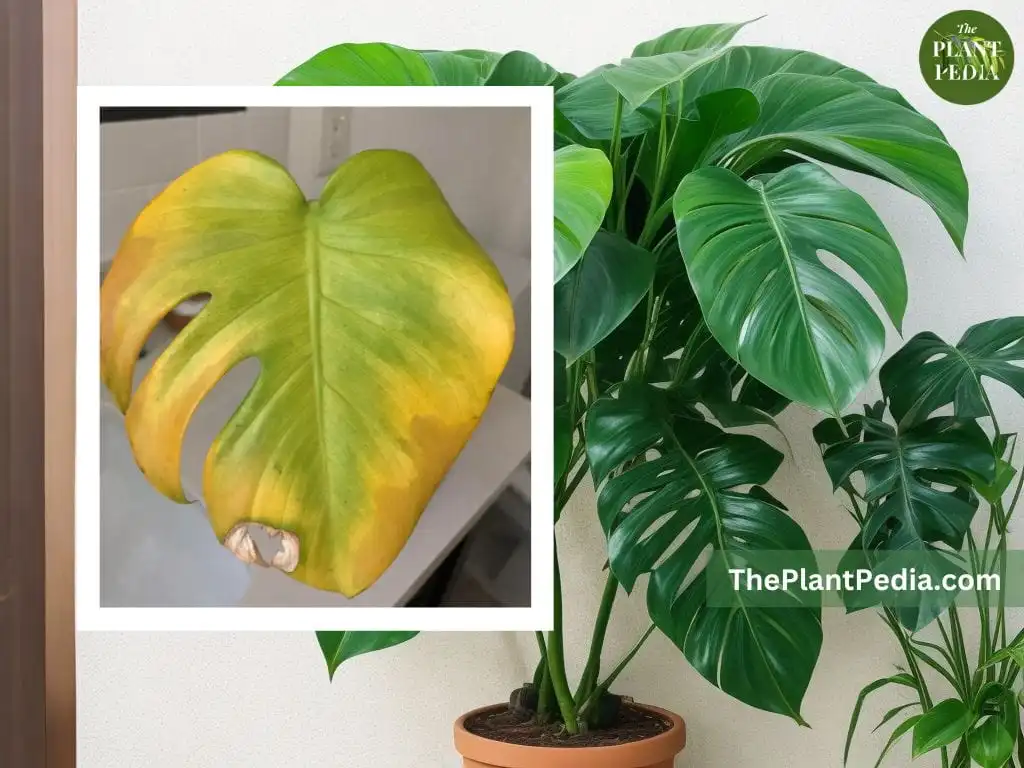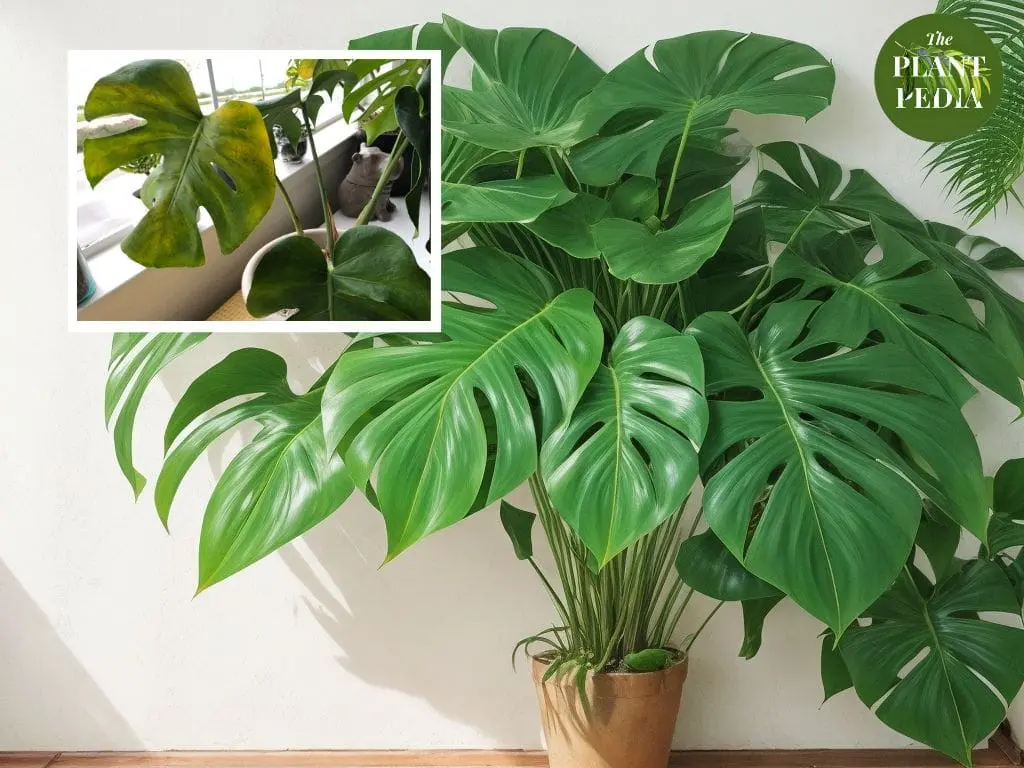The Monstera Deliciosa, with its large, glossy leaves and unique fenestrations, is a popular choice among houseplant enthusiasts.
However, if you’ve noticed your once vibrant green Monstera turning yellow, it can be a cause for concern.
In this detailed guide, we’ll delve into the various factors that could be causing this issue and provide detailed explanations along with practical solutions to help you revive your beloved plant.
Table of Contents
Understanding Monstera Plants
Before we dive into the reasons behind the yellowing of your Monstera, it’s crucial to understand the basic requirements of this plant.
Monstera Deliciosa is native to the rainforests of Central and South America, which means it thrives in warm, humid environments with dappled sunlight.
Read: Monstera Plant: Origin, Species, Care, & All.

Why is My Monstera Turning Yellow?
There are a few reasons why your Monstera might be turning yellow. The most common causes are:
1. Improper Watering
Additional Details:
- Symptoms: Overwatering can lead to wilting, yellowing, and even blackening of the leaves. The soil may become waterlogged, and the roots may appear brown or black and mushy. On the other hand, underwatering can result in dry, crispy leaves that turn yellow and eventually brown.
- Preventive Measures: Besides ensuring proper drainage in the pot, it’s important to water your Monstera thoroughly but allow the top inch of soil to dry out before watering again. This helps prevent waterlogging and promotes healthy root development.
2. Lighting Issues
Additional Details:
- Symptoms: If your Monstera is receiving too much direct sunlight, you may notice sunburned patches on the leaves, which appear as brown or yellow spots. In contrast, insufficient light can cause slow growth, weak stems, and yellowing leaves.
- Optimal Lighting Conditions: Ideally, place your Monstera in a location with bright, indirect sunlight. This can be achieved by providing filtered light through curtains or placing it a few feet away from a north or east-facing window.
3. Nutrient Deficiency
Additional Details:
- Symptoms: Nitrogen deficiency is one of the most common nutrient deficiencies in Monstera plants. It manifests as overall yellowing of the leaves, particularly in older growth. The leaves may also appear smaller and less vibrant.
- Fertilizing Tips: To rectify nutrient deficiencies, choose a balanced, water-soluble fertilizer that includes micronutrients. Follow the recommended dosage instructions on the fertilizer packaging, and consider fertilizing during the plant’s active growing season (typically spring and summer).
Read: (Top 10) Monstera Fertilizer: Why, When, How (A to Z).
4. Pests and Diseases
Additional Details:
- Pest Identification: Common pests like spider mites may cause stippling or yellow speckling on the leaves, while aphids can lead to distorted growth and yellowing. Fungal infections can manifest as spots or lesions on the leaves.
- Treatment Approaches: For minor infestations, you can try natural remedies like insecticidal soap or neem oil. In severe cases, you might need to resort to chemical treatments. Always follow the instructions on the chosen treatment.
Read: Mosaic Virus Monstera: Symptoms, Prevention, & Care.
5. Environmental Stress
Additional Details:
- Temperature and Humidity Fluctuations: Monstera plants are sensitive to sudden changes in temperature and humidity. Exposure to cold drafts or excessively dry air can lead to stress and yellowing.
- Maintaining Consistency: To prevent environmental stress, keep your Monstera in a stable environment. Avoid placing it near heaters, air conditioners, or windows that experience extreme temperature fluctuations.
6. Root-bound Conditions
Additional Details:
- Signs of Root-bound Plants: If your Monstera has become root-bound, you may notice roots circling around the edges of the pot and even emerging from the drainage holes. The plant may exhibit stunted growth and nutrient deficiencies.
- Repotting Guidelines: When repotting, choose a container that’s 1-2 inches larger in diameter than the current one. Use a well-draining potting mix to ensure proper aeration for the roots.
7. Natural Aging Process
Additional Details:
- Differentiating Normal Aging from Stress-induced Yellowing: It’s important to distinguish between naturally aging leaves and those yellowing due to stress or other factors. Older leaves will yellow from the base and eventually fall off, while stress-induced yellowing may occur more abruptly.
- Pruning Strategy: Regularly pruning older, yellowing leaves allows the plant to allocate nutrients to newer growth, promoting overall health and vitality.
By addressing these specific aspects in detail, you’ll be better equipped to identify and resolve the issues causing your Monstera’s leaves to turn yellow. Remember, attentive care and timely intervention can make a significant difference in the overall well-being of your plant.

Additional Discussion Points
Soil Health and Composition
Explanation: The type of soil your Monstera is planted in plays a crucial role in its overall health. Well-draining, aerated soil with good moisture retention is essential. A mix of potting soil, perlite, and orchid bark is a popular choice for Monstera plants.
Optimal Soil pH: Monstera plants prefer slightly acidic to neutral soil with a pH range of 6.1 to 7.5. Maintaining the correct pH level ensures that essential nutrients are readily available to the plant.
Monitoring Humidity Levels
Explanation: Monstera plants are native to tropical rainforests where humidity levels are high. In indoor environments, especially during winter when central heating can dry the air, maintaining adequate humidity is crucial.
Humidity Solutions: You can increase humidity around your Monstera by misting its leaves regularly, using a humidifier, or placing a tray filled with water and pebbles near the plant. Grouping plants together can also create a microclimate with higher humidity levels.
Water Quality and pH
Explanation: The quality of water used for watering your Monstera is often overlooked but can significantly impact its health. Water with a high mineral content or extreme pH levels can lead to nutrient imbalances and affect the plant’s ability to absorb them.
Watering Recommendations: Using distilled or filtered water can help ensure a consistent pH level and prevent the buildup of harmful minerals in the soil. Always allow the water to come to room temperature before watering to avoid shocking the plant.
Understanding Growth Patterns
Explanation: Monstera plants exhibit unique growth habits, including the development of aerial roots and the characteristic fenestrations or splits in their leaves. Understanding these growth patterns can help you provide the right support for your plant.
Aerial Roots: Aerial roots are natural for Monstera plants. They help anchor the plant and absorb moisture and nutrients from the air. Providing a moss pole or trellis can encourage healthy aerial root development.
Identifying and Responding to Pest Infestations
Explanation: Regularly inspecting your Monstera for signs of pests is crucial for early intervention. Recognizing common pests like mealybugs, scale insects, and spider mites is essential to prevent them from causing significant damage.
Natural Pest Control: In addition to insecticidal soaps and neem oil, introducing natural predators like ladybugs or releasing beneficial nematodes can be an effective, eco-friendly way to control pest populations.
Read: Monstera Plant Disadvantages And Benefits.
FAQs:
Why is My Monstera Turning Yellow with Brown Spots?
Explanation: Yellowing with brown spots on Monstera leaves may indicate a range of issues. This could be due to overwatering, leading to root rot and nutrient deficiency. It might also be a sign of environmental stress or fungal infections.
Solution:
- Evaluate watering habits and adjust to prevent waterlogged soil.
- Check for pests or diseases; treat accordingly if detected.
- Ensure proper drainage in the pot to prevent water accumulation.
Why is My Monstera Turning Yellow in Water?
Explanation: If you’re observing yellowing in a Monstera that’s growing in water, it’s likely an indication of overwatering. While Monstera plants can thrive in water, they are susceptible to root rot if water conditions are not properly managed.
Solution:
- Change the water regularly to prevent stagnation and nutrient depletion.
- Consider using a well-balanced liquid fertilizer for aquatic plants to provide essential nutrients.
Should I Cut Off Yellow Leaves on My Monstera?
Explanation: Yes, it’s advisable to trim yellow leaves on your Monstera. These leaves are likely no longer receiving or contributing nutrients to the plant. By pruning them, you redirect the plant’s resources towards healthy growth.
Pruning Tips:
- Use clean, sharp scissors or pruning shears to make clean cuts.
- Trim the yellow leaf at its base, where it connects to the stem.
How to Fix Yellow Monstera Leaves?
Explanation: Fixing yellow Monstera leaves involves addressing the underlying causes. This can include adjusting watering practices, optimizing lighting conditions, and ensuring proper nutrient levels.
Steps to Fix Yellowing:
- Evaluate Watering: Allow the top inch of soil to dry out before watering. Adjust watering frequency based on environmental conditions.
- Optimize Lighting: Ensure your Monstera receives bright, indirect sunlight.
- Check Nutrient Levels: Consider using a balanced, water-soluble fertilizer to address nutrient deficiencies.
- Inspect for Pests and Diseases: Regularly check your plant for signs of infestations and treat accordingly.
Remember, patience is key when nursing a yellowing Monstera back to health. It may take some time for the plant to recover and start producing new, healthy growth. Keep a watchful eye on its progress and adjust care practices as needed.
Conclusion
Caring for a Monstera Deliciosa can be a rewarding experience, but it’s essential to be attentive to its needs.
By understanding the potential causes of yellowing leaves, you can take proactive steps to address the issue and ensure the continued health and vitality of your plant.
Remember, each plant is unique, so observing and adapting to its specific requirements is key to a thriving Monstera.
With the right care, you can expect to enjoy lush, green foliage for years to come. Happy gardening!


